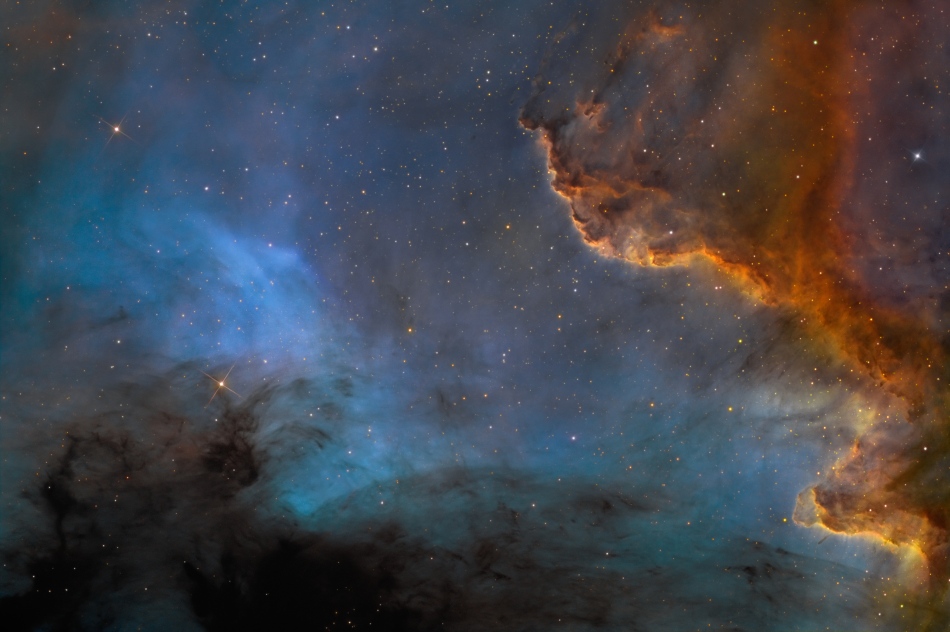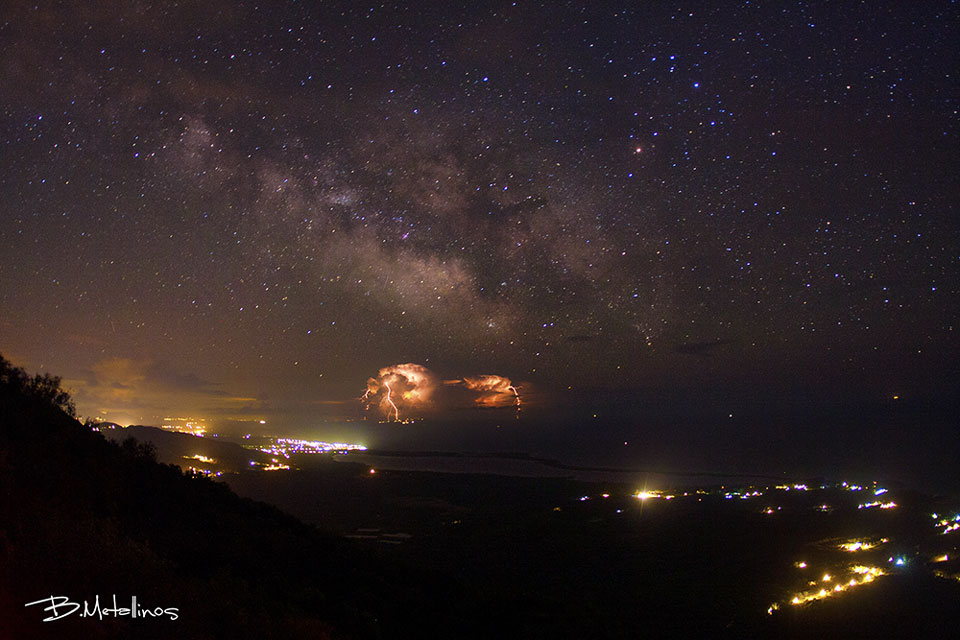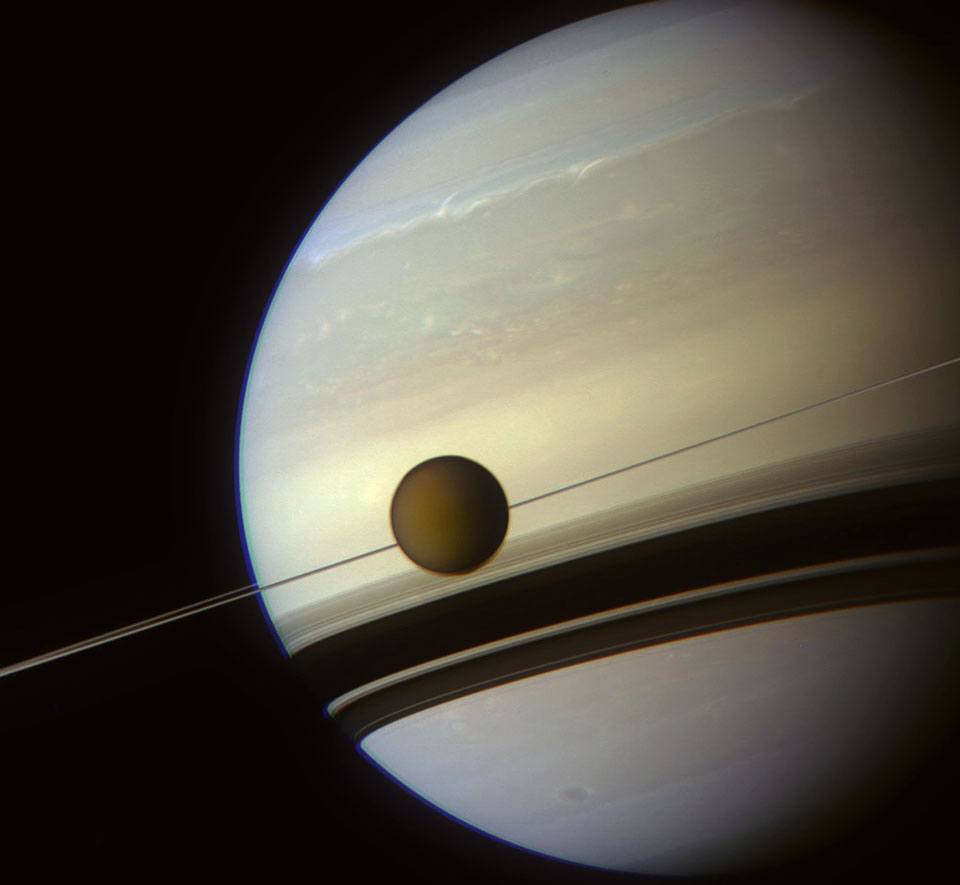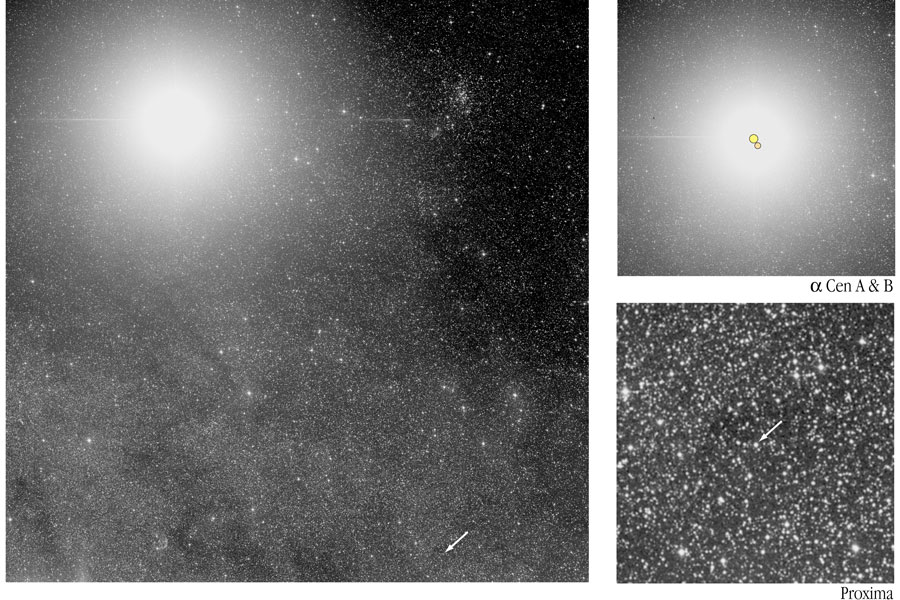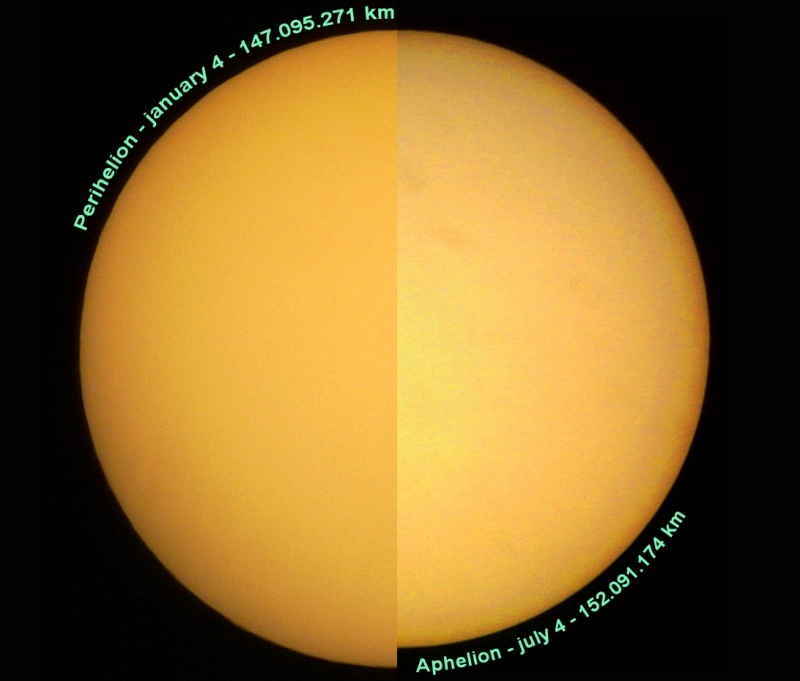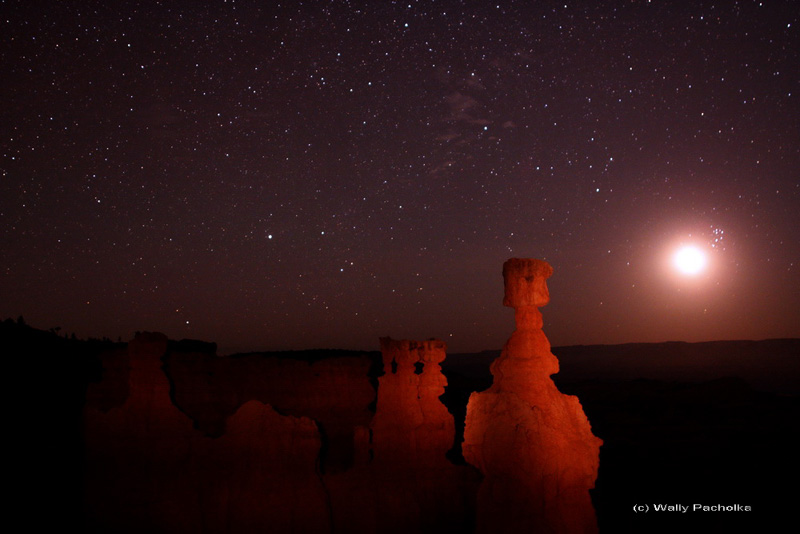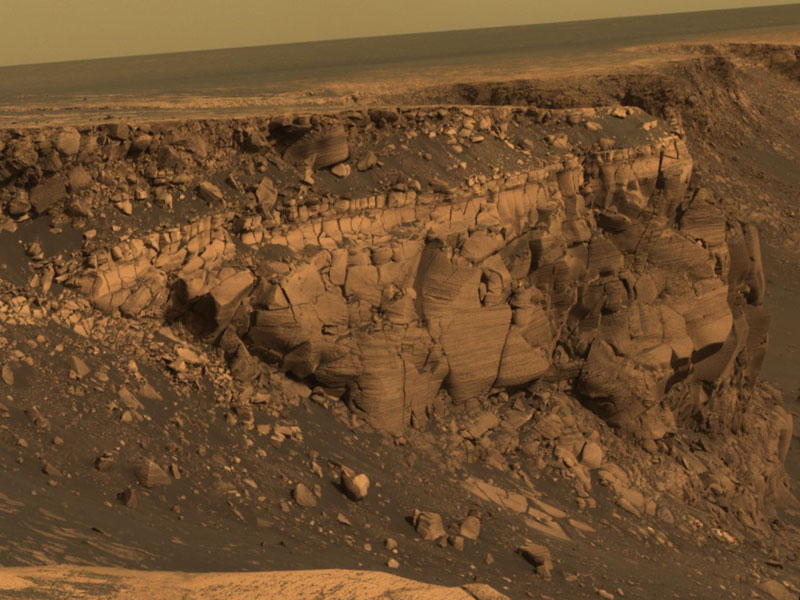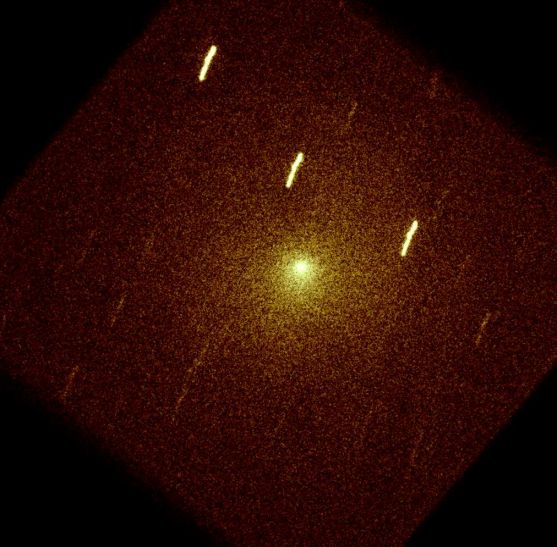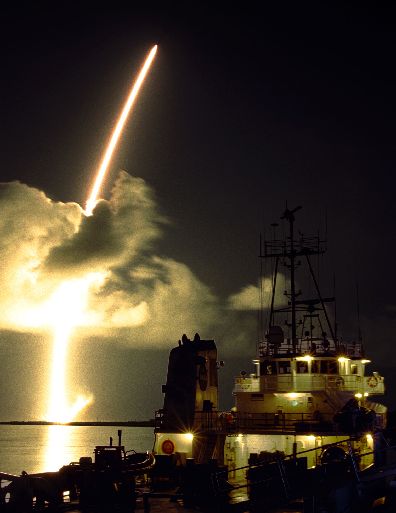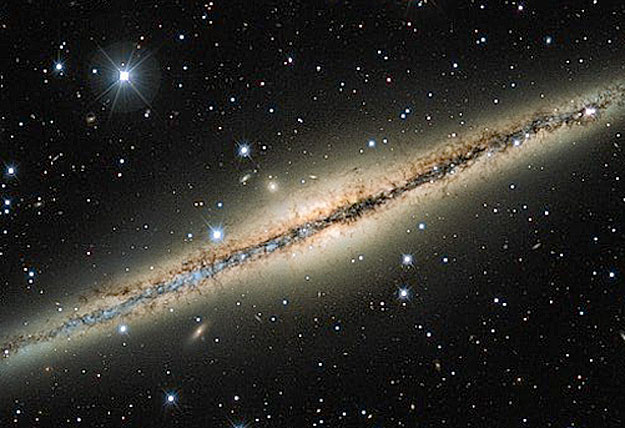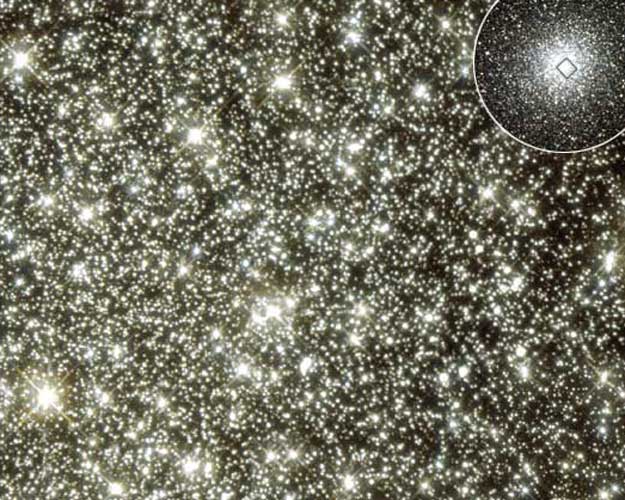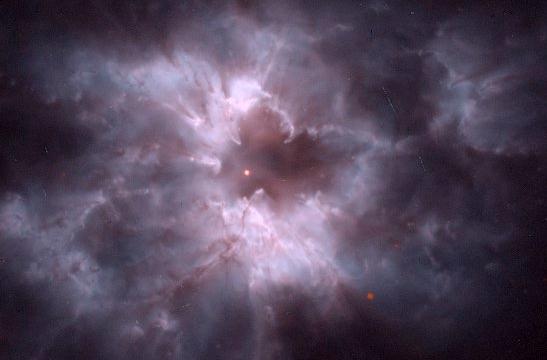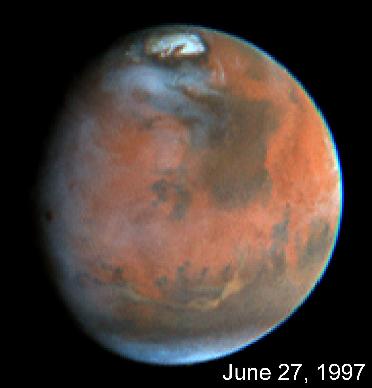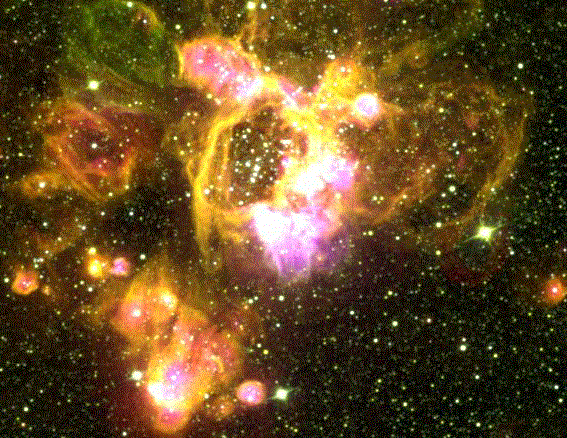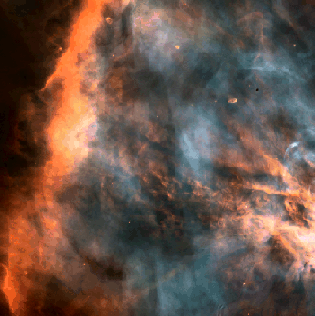| << Previous | Index | Next >> |
2015 On June 30 Venus and Jupiter were actually far apart, but both appeared close in western skies at dusk. Near the culmination of this year's gorgeous conjunction, the two bright evening planets are captured in the same telescopic field of view in this sharp digital stack of images taken after sunset from Poznań in west-central Poland. In fact, banded gas giant Jupiter was about 910 million kilometers from Poland. That's over 11 times farther than crescent Venus, only 78 million kilometers distant at the time. But since the diameter of giant planet Jupiter is over 11 times larger than Venus both planets show about the same angular size. Of course, 16th century Polish astronomer Nicolaus Copernicus would also have enjoyed the simultaneous telescopic view including Jupiter's four Galilean moons and a crescent Venus. Observations of Jupiter's moons and Venus' crescent phase were evidence for the Copernican or heliocentric model of the solar system.
2014 The prominent ridge of emission featured in this vivid skyscape is known as the Cygnus Wall. Part of a larger emission nebula with a distinctive shape popularly called The North America Nebula, the ridge spans about 10 light-years along an outline that suggests the western coast of Mexico. Constructed from narrowband image data, the cosmic close-up maps emission from sulfur, hydrogen, and oxygen atoms to red, green, and blue colors. The result highlights the bright ionization front with fine details of dark, dusty forms in silhouette. Sculpted by energetic radiation from the region's young, hot, massive stars, the dark shapes inhabiting the view are clouds of cool gas and dust with stars likely forming within. The North America Nebula itself, NGC 7000, is about 1,500 light-years away. To find it, look northeast of bright star Deneb in the high flying constellation Cygnus.
2013 It may appear, at first, like the Galaxy is producing the lightning, but really it's the Earth. In the foreground of the above picturesque nighttime landscape is the Greek Island of Corfu, with town lights surrounding Lake Korrision. Visible farther in the distance are lights from the town of Preveza on the Greek mainland. In the more distant sky a thunderstorm is threatening, with two lightning strokes caught together during this 45 second wide-angle exposure taken in mid-May. The lightning branch on the left appears to be striking near Preveza, whereas the lightning strike on the right appears to be striking near Mount Ainos on the Greek Island of Cephalonia. Much farther in the distance, strewn about the sky, are hundreds of stars in the neighborhood of our Sun in the Milky Way Galaxy. Furthest away, arching over the entire panorama, are billions of stars that together compose the central band of our Milky Way.
2012 Humanity's robot orbiting Saturn has recorded yet another amazing view. That robot, of course, is the spacecraft Cassini, while the new amazing view includes a bright moon, thin rings, oddly broken clouds, and warped shadows. Titan, Saturn's largest moon, appears above as a featureless tan as it is continually shrouded in thick clouds. The rings of Saturn are seen as a thin line because they are so flat and imaged nearly edge on. Details of Saturn's rings are therefore best visible in the dark ring shadows seen across the giant planet's cloud tops. Since the ring particles orbit in the same plane as Titan, they appear to skewer the foreground moon. In the upper hemisphere of Saturn, the clouds show many details, including dips in long bright bands indicating disturbances in a high altitude jet stream. Recent precise measurements of how much Titan flexes as it orbits Saturn hint that vast oceans of water might exist deep underground.
2011 The closest star system to the Sun is the Alpha Centauri system. Of the three stars in the system, the dimmest -- called Proxima Centauri -- is actually the nearest star. The bright stars Alpha Centauri A and B form a close binary as they are separated by only 23 times the Earth- Sun distance - slightly greater than the distance between Uranus and the Sun. In the above picture, the brightness of the stars overwhelm the photograph causing an illusion of great size, even though the stars are really just small points of light. The Alpha Centauri system is not visible in much of the northern hemisphere. Alpha Centauri A, also known as Rigil Kentaurus, is the brightest star in the constellation of Centaurus and is the fourth brightest star in the night sky. Sirius is the brightest even thought it is more than twice as far away. By an exciting coincidence, Alpha Centauri A is the same type of star as our Sun, causing many to speculate that it might contain planets that harbor life.
2010 A mere 50 light-years away, young star Beta Pictoris became one of the most important stars in the sky in the early 1980s. Satellite and ground-based telescopic observations revealed the presence of a surrounding outer, dusty, debris disk and an inner clear zone about the size of our solar system -- strong evidence for the formation of planets. Infrared observations from European Southern Observatory telescopes subsequently detected a source in the clear zone, now confirmed as a giant planet orbiting Beta Pic. The confirmation comes as the planet is detected at two different positions in its orbit. Designated Beta Pictoris b, the giant planet must have formed rapidly as Beta Pic itself is only 8 to 20 million years old. With an orbital period estimated between 17 and 44 years, Beta Pictoris b could lie near the orbit of Saturn if found in our solar system, making it the closest planet to its parent star directly imaged ... so far.
2009 This year Aphelion, the point in Earth's elliptical orbit when it is farthest from the Sun, occurs tomorrow, July 4th. Of course, that doesn't affect the seasons on our fair planet. Those are determined by the tilt of Earth's axis of rotation and not Earth's distance from the Sun, so July is still winter in the south and summer in northern hemisphere. But it does mean that on July 4th the Sun will be at its smallest apparent size. This composite neatly compares two pictures of the Sun taken with the same telescope and camera on the dates of Perihelion (closest approach) and Aphelion in 2008. The image labels include Earth's distance in kilometers from the Sun on the two dates. Otherwise difficult to notice, the change in the Sun's apparent diameter between Perihelion and Aphelion is clear. The difference amounts to a little over 3 percent.
2008 The strange-looking rock formations in the foreground of this skyscape are called hoodoos. Towers of weathered, eroded sedimentary rock, hoodoos are found in arid regions of planet Earth and are particularly abundant in an area known as Bryce Canyon National Park in southern Utah, USA. The more familiar night sky pictured here was recorded early Monday morning and includes bright star Capella, alpha star of the constellation Auriga, left of center. On the far right, a very over exposed crescent Moon dominates the sky in close conjunction with the sister stars of the Pleiades cluster. The curious shapes of the two tall, illuminated hoodoos suggest their popular monikers; Thor's Hammer (right) and The Temple of Osiris.
2007 We're going in. The robotic Opportunity rover currently rolling across Mars has been prowling around the edge of the largest crater it has visited since landing over three years ago. It has been studying Victoria crater and looking for a way in. Now scientists on Earth have decided to take a calculated risk and plan to send Opportunity right into this ancient Martian crater over the next few weeks. Pictured is Cape St. Vincent, part of the wall of Victoria Crater next to where Opportunity will descend. The wall itself appears to contain clues about the Martian terrain before the impact that created Victoria crater, and so will be studied during the daring descent. Above the crater wall, far in the distance, lies a relatively featureless Martian horizon.
2006 This Martian vista is only part of one of the greatest panoramic views of Mars that has ever been attempted. The expansive mosaic is helping to keep the robotic Spirit rover busy over the energy draining winter in the southern hemisphere of Mars. During the winter, Spirit is constrained to stay on the side of McCool Hill in order to keep its solar panels pointed toward the Sun. The panorama has so far involved over 800 exposures, very little digital compression, and will take over a month to complete. The view shown is toward Husband Hill, a hill that Spirit climbed last year. A careful inspection of the above image shows tracks crossing from the center to the right.
2005 Comet Tempel 1 is targeted for a collision with the impactor probe from NASA's Deep Impact Spacecraft at about 1:52am EDT on July 4th (other time zones). Cameras on the impactor probe and the flyby spacecraft will capture close-up images of the event - expected to produce a crater on the surface of the comet's nucleus. Of course, Earth-orbiting and ground-based telescopes will be watching too, including instruments on the Swift satellite normally used to spot gamma-ray bursts in the distant universe. Swift's ultraviolet telescope recorded this picture of Tempel 1 on June 29th. Because the image is registered on the comet, the background stars appear as short trails. Want to follow the encounter? Media coverage chronicling the event, and the possibilities for viewing the comet with small telescopes can be found through the Deep Impact website. Updated images will also be available from the Kitt Peak National Observatory.
2004 Saturn Orbiter Cassini with Titan Probe Huygens attached rocketed into early morning skies on October 15, 1997. The mighty Titan 4B Centaur rocket is seen here across the water, arcing away from Launch Complex 40 at Cape Canaveral Air Station. Cassini, a sophisticated robot spacecraft was actually headed toward inner planet Venus, the first way point in its 7 year, 2.2 billion mile interplanetary journey to Saturn. In fact, Cassini swung by Venus during April 1998 and June 1999, Earth in August 1999, and Jupiter in December 2000. During each of these "gravity assist" encounters the six ton spacecraft picked up speed, reaching Saturn only three days ago. Cassini is now orbiting the ringed gas giant, with the Huygens Probe scheduled to separate from the spacecraft in December. The probe's descent to the surface of Saturn's large moon Titan will be the most distant landing ever attempted.
2003 The Vela pulsar is a neutron star born over 10,000 years ago in a massive supernova explosion. Above, false-color x-ray images from the Chandra Observatory reveal details of this remnant pulsar's x-ray bright nebula along with emission from a spectacular jet of high-energy particles. In this time-lapse series of pictures, the jet seems to dance around very much like an out-of-control firehose, shooting along the pulsar's direction of motion (toward the top right corner) to a length of about half a light-year while whipping back and forth at about half the speed of light. Highly magnetized and spinning over 10 times a second, the Vela pulsar is thought of as a cosmic high-voltage generator, powering the x-ray nebula and dynamic cosmic jet. A mere 800 light-years away the pulsar itself is located near the lower left corner in the four panels.
2002 What is going on in NGC 891? This galaxy appeared previously to be very similar to our own Milky Way Galaxy: a spiral galaxy seen nearly edge-on. However, recent high-resolution images of NGC 891's dust show unusual filamentary patterns extending well away from its Galactic disk. This interstellar dust was probably thrown out of the galactic disk toward the halo by stellar supernovae explosions. Because dust is so fragile, its appearance after surviving disk expulsion can be very telling. Newly discovered phenomena, however, sometimes appear so complex that more questions are raised than are answered.
2001 What is causing the unusual flashes behind globular cluster M22? This teeming ball of stars is the brightest globular cluster visible from Earth's northern hemisphere. M22, shown in full in the inset, spans about 50 light-years and lies 8,500 light-years away toward the constellation of Sagittarius. M22's center was recently imaged repeatedly by the high resolution Hubble Space Telescope. Behind M22 are many more stars near the center of our Galaxy. Unexpectedly, several stars near the Galactic center -- well behind M22 -- appeared to nearly double in brightness and return to normal within 20 hours. One hypothesis posed to explain these quick brightness changes is the gravitational lens effect of large planets roaming freely in the cluster. One problem with this is that no such planetary population was previously known! Future observations are planned to better understand these mysterious flashes.
2000 The Pelican Nebula is slowly being transformed. IC 5070, the official designation, is divided from the larger North America Nebula by a molecular cloud filled with dark dust. The Pelican, however, receives much study because it is a particularly active mix of star formation and evolving gas clouds. The above picture was produced in two specific colors to better understand these interactions. Here, hot hydrogen gas glows in red, while cooler Sulfur glows blue-green. The light from young energetic stars is slowly transforming the cold gas to hot gas, with the advancing boundary between the two known as an ionization front. Particularly dense filaments of cold gas are seen to still remain. Millions of years from now this nebula might no longer be known as the Pelican, as the balance and placement of stars and gas will leave something that appears completely different.
1999 Like a butterfly, a white dwarf star begins its life by casting off a cocoon that enclosed its former self. In this analogy, however, the Sun would be a caterpillar and the ejected shell of gas would become the prettiest of all! The above cocoon, the planetary nebula designated NGC 2440, contains one of the hottest white dwarf stars known. The white dwarf can be seen as the bright dot near the photo's center. Our Sun will eventually become a "white dwarf butterfly", but not for another 5 billion years. The above false color image and was post-processed by Forrest Hamilton.
1998 Photographed from the approaching Space Shuttle Endeavour, the Mir space station floats above the clouds of planet Earth. Mir's modular construction, bristling with solar panels and antennas, lends it a slightly whimsical, insect-like appearance. Astronaut Andrew Thomas was dropped off at Mir by Endeavour in January and recently picked up by the Space Shuttle Discovery during STS-91, the ninth and last Mir docking mission. Thomas' 4 1/2 month stay culminates the shuttle-Mir program in which seven U.S. astronauts spent a total of 977 days with Russian crews on board Mir. The experience gained will be applied toward the construction of the International Space Station scheduled to begin with launches in November and December 1998.
1997 Mars Pathfinder is nearing the end of its 7 month journey. The robot spacecraft is scheduled to use parachutes, rockets, and airbags to "bouncedown" on the red planet tomorrow - July 4th. This Hubble Space Telescope image of Mars was taken a few days ago to check on the weather. The pathfinder landing site, on the ancient floodplain Ares Vallis, is just right of center - 500 miles southeast of where Viking 1 landed in 1976. Along with the martian north polar cap, some water ice clouds are visible in both the northern and southern hemisphere. About 600 miles south of the landing site a dust storm can be seen as a brownish ribbon stretching through the the Valles Marineris, a continent sized canyon system. Fortunately, the dust storm is not expected to seriously affect operations at the landing site.
1996 Why is there a hole in the center of this nebula? A leading explanation is that it is caused by the stellar winds from the stars that live there. Stars - including the Sun - expel electrons, protons, and other charged ions in a steady stream - the stellar wind. The wind ions push out the normal hydrogen and helium gas found glowing in the nebula. This star forming region is located in the Large Magellanic Cloud. This picture is a composite of three separate photographs, each sensitive to only one specific color of light - a color that distinguishes a specific chemical element. It is currently not known why stars emit a stellar wind.
1995 The Great Nebula in Orion, M42, can be found on the night sky just below and to the left of the easily identifiable belt of three stars in the popular constellation Orion. This nebula is one of the closest stellar nurseries - where young stars are being formed even now. Clumps of gas (mostly hydrogen and helium) and dust in the nebula are squeezed together by their own gravity until they collapse and form stars. Some stars we can see here partially obscured by the nebula, are only about 100,000 years old - just babies compared to the 5 billion (5,000,000,000) years of our Sun.
| << Previous | Index | Next >> |

